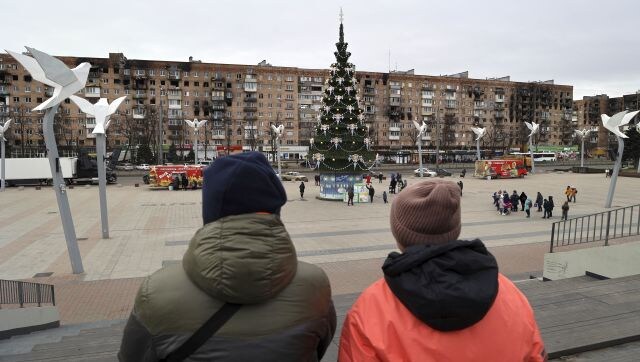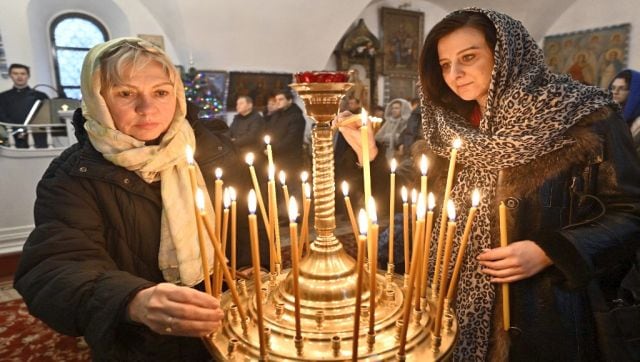Explained: What is Orthodox Christmas for which Vladimir Putin has ordered a ceasefire in Ukraine?
Explained: What is Orthodox Christmas for which Vladimir Putin has ordered a ceasefire in Ukraine?

Amid the raging Russia-Ukraine war — which is now in Day 317 — that has claimed thousands of lives, flattened entire cities and left the world watching in horror, Russia’s Vladimir Putin on Thursday announced a temporary ceasefire of 36 hours during Orthodox Christmas, a move that war-battered Kyiv swiftly branded as “hypocrisy”.
This is the first time Russia has introduced a full ceasefire in Ukraine since the offensive began in February last year and comes after a request from Russia’s 76-year-old Orthodox leader Patriarch Kirill.
“I instruct the defence minister of the Russian Federation to introduce from 12:00 (0900 GMT) on 6 January, 2023 until 24:00 (2100 GMT) on 7 January 2023 a ceasefire along the entire line of contact between the sides in Ukraine,” the Kremlin said in a statement.
“Given the fact that a large number of citizens professing Orthodoxy live in the areas of combat, we call on the Ukrainian side to declare a ceasefire and give them the opportunity to attend church services on Christmas Eve, as well as on the Day of the Nativity of Christ,” the statement added.
However, Putin’s move has been rejected by Kyiv with Ukraine president Volodymyr Zelenskyy saying the truce was an attempt to stop his country’s military advances.
In his nightly address, the Ukrainian leader said, unusually in Russian, that that Moscow wanted to use the truce as a cover to stop Ukrainian advances in the eastern Donbas region and bring in more men and equipment.
“What will that give them? Only yet another increase in their total losses,” he added.
Ukrainian presidential adviser, Mykhailo Podolyak, chimed in that there could be no “temporary truce” until Russian forces withdrew from all the areas they had occupied. He also called it a “propaganda gesture”, a “trivial ploy”, and an attempt by Russia to invite pressure on Ukraine from European countries by pretending it was “humanistic”.
First. Ukraine doesn’t attack foreign territory & doesn’t kill civilians. As RF does. Ukraine destroys only members of the occupation army on its territory…
Second. RF must leave the occupied territories – only then will it have a “temporary truce”. Keep hypocrisy to yourself.— Михайло Подоляк (@Podolyak_M) January 5, 2023
As Russia and Ukraine trade barbs on the ‘ceasefire’, we take a closer look at what exactly is Orthodox Christmas and why is it celebrated on 7 January instead of 25 December.

What is Orthodox Christmas?
Approximately 260 million people worldwide, those in majority-Orthodox countries in Eastern Europe, like Russia, Ukraine and Greece, and in communities in Ethiopia, Egypt, and elsewhere, celebrate Christmas on 7 January rather than 25 December and it is called Orthodox Christmas.
The holiday stems from the decision by Orthodox Christian groups to follow the Julian calendar created by the Romans, rather than the Gregorian calendar that was embraced by most Christian countries in 1582. The dates of several Christian holidays, including Christmas and Easter, differ from one to the other.
Also read: Ukrainians break tradition, move up Christmas to part ways with Russia
Confused about all of it? We simplify it for you.
Prior to the 16th Century, a calendar known as the Julian calendar was used which was a solar calendar adopted by Roman ruler Julius Caesar in 46 BC. However, as time passed, the calendar’s calculations seemed to have an issue of their own: it overestimate the length of the solar year by about 11 minutes. As a result, the calendar and the solar year became increasingly out of sync as the centuries progressed.
By 1852, the dates of important Christian holidays had drifted too far and Pope Gregory XIII was concerned. He called for a group of astronomers and after discussions introduced a new calendar — the Gregorian calendar — which is what is widely used all over the world to this day.
But the new calendar meant an occasional overlap between Passover and Easter — a move that went against the holy texts of Orthodox Christianity and hence this denomination rejected the Gregorian calendar and continued to rely on the Julian calendar
Over the years, the differences in these two calendars meant that certain religious holidays would fall under two different dates, which is essentially why the majority of the world celebrate on 25 December, in accordance to the Gregorian calendar, while a few Orthodox Christians celebrate the birth of Jesus Christ on 7 January, in accordance to the Julian calendar.
Also read: Priests or spies? How churches in Ukraine are being used in the war

Which countries mark Orthodox Christmas?
Several countries celebrate Orthodox Christmas on 7 January, including Russia that is home to more than a third (39 per cent) of the world’s Christians.
Other nations celebrating on 7 January are Belarus, Egypt, Ethiopia, Georgia, Kazakhstan, Macedonia, Moldova, Montenegro, Serbia, and Ukraine.
Armenia observes Christmas Day on 6 January. After a meeting of leaders in 1923, most stayed with the Julian calendar but Orthodox Christians in Greece, Cyprus and Romania chose to move the date in line with the Gregorian calendar.
How different is Orthodox Christmas?
Orthodox Christmas traditions differ depending on the country, church and local customs. While they do have Christmas trees, wreaths and some gifts, it’s not like the commercialised Christmas we are accustomed to. Orthodox Christmas is focused on devout religious celebrations.
Traditionally, Orthodox Christians fast for up to 40 days leading up to Christmas, preparing for the birth of Christ by abstaining from meat, dairy, fish, wine, and olive oil. After a vigil on Christmas Eve, Christmas itself is celebrated as one of the Church’s 12 Great Feasts, with churchgoing and celebration at home.
In Russia, a 12-course meal is laid out laden with dishes like beet salad, borscht, boiled potatoes with onions, honey and raisins to represent good fortune and piroshki, a traditional sauerkraut dumpling. Russian Salmon pies (Kulebyaka) and Russian meat dumplings are also eaten during this feast.
In Georgia, clergy and people in religious costumes parade through the streets, singing carols and walking toward the church. Called Alilo, the procession’s name is derived from that of a song traditionally sung by children on Christmas Eve as they go from door to door, collecting money and small gifts. That custom exists in other places, too, like Romania and Greece.
There is also an Orthodox Christmas Day custom of walking in procession to a body of water — be that the sea, river or lakes — to bless it. If the water is iced over, they will make holes to reach it.
Whatever the differences between Orthodox Christmas and Christmas, they both ultimately mean to celebrate the birth of Jesus Christ and is the most heart-warming and special time of the year.
With inputs from agencies
Read all the Latest News, Trending News, Cricket News, Bollywood News,
India News and Entertainment News here. Follow us on Facebook, Twitter and Instagram.
What's Your Reaction?


























































